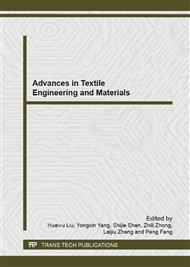p.705
p.711
p.715
p.722
p.726
p.730
p.734
p.737
p.741
Influence of Super Hydrophobic Modification on Protective Performance of PTFE Micropore Membrane
Abstract:
Using self - prepared fluorochemical surfactant, PTFE micropore membrane was modified to improve its hydrophobicity. The surface morphology of the membrane was observed by SEM and its Contact angle was determined by. The protective property of the membranes against mustard gas was evaluated using the break-through test. The result shows that, the thesis put forward a novel BC protection idea that through membrane surface modification the poisonous agent can be rolled into liquid spheres and slided away from the membrane surface automatically because of the low surface tension of the membrane, which stands out from the traditional methodology by quick poisonous agent surface expansion and evaporation on the surface of the BC protective material.
Info:
Periodical:
Pages:
726-729
Citation:
Online since:
December 2012
Authors:
Price:
Сopyright:
© 2013 Trans Tech Publications Ltd. All Rights Reserved
Share:
Citation:


